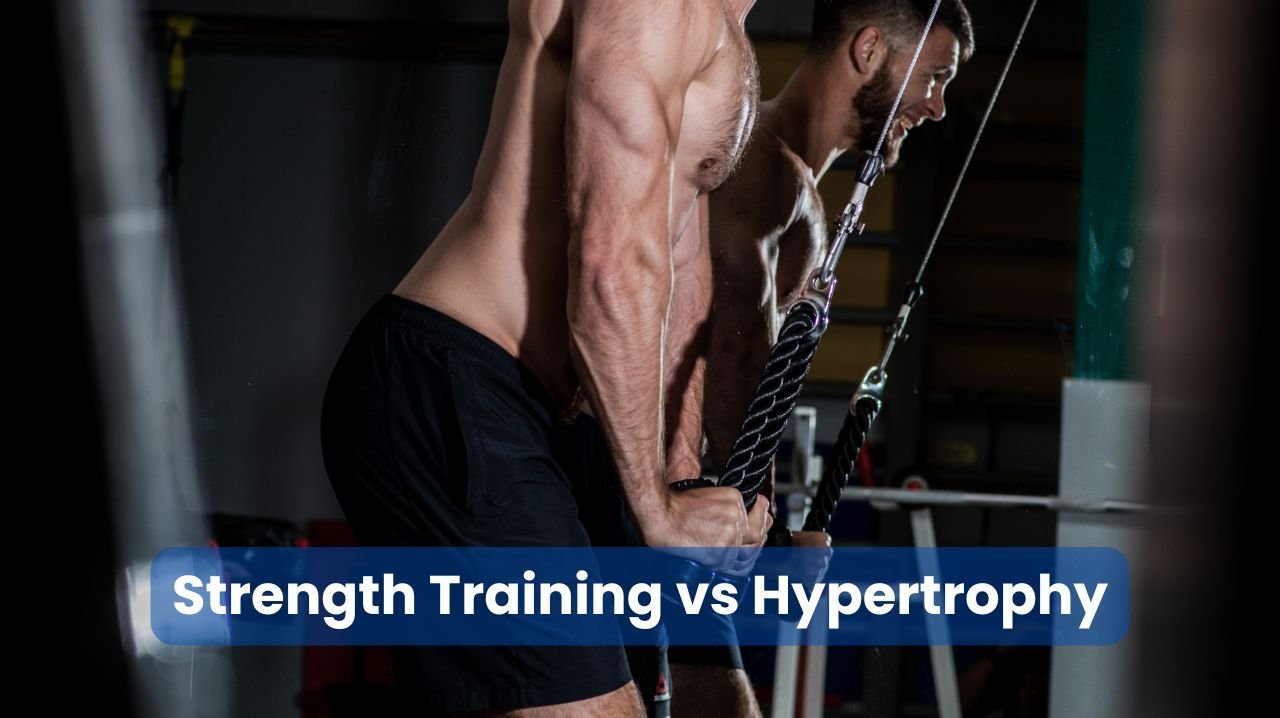Strength Training vs Hypertrophy: Which Is Best for Muscle Gains?
For fitness enthusiasts and bodybuilders alike, the question of how to maximize muscle gains is a constant topic of discussion.
Two primary approaches often come to the forefront: strength training and hypertrophy training. While both methods can lead to impressive results, they differ in their focus and execution.
This article will delve into the intricacies of strength training and hypertrophy, comparing their benefits, techniques, and effectiveness for muscle growth.
👉 Pack On Muscle Mass and Get Bigger and Stronger
👉 Burn Fat and Get Seriously Ripped
👉 Get Explosive Strength and Maximum Stamina
👉 Become A Gym Beast With Legal SARMs Alternatives
Understanding Strength Training
Strength training, as the name suggests, primarily focuses on increasing muscular strength. This type of training typically involves lifting heavy weights for fewer repetitions. The goal is to improve the amount of force a muscle can produce, rather than necessarily increasing its size.
Key characteristics of strength training include:
- Low rep ranges (usually 1-5 repetitions per set)
- High weight loads (often 85-100% of one-rep max)
- Longer rest periods between sets (3-5 minutes)
- Emphasis on compound exercises (squats, deadlifts, bench press)
- Focus on progressive overload
Strength training stimulates neuromuscular adaptations, improving the efficiency of motor unit recruitment and enhancing the coordination between muscle groups. This leads to increased strength without necessarily causing significant muscle hypertrophy.
Exploring Hypertrophy Training
Hypertrophy training, on the other hand, is specifically designed to increase muscle size. This approach typically involves moderate weights and higher repetitions, creating metabolic stress and mechanical tension in the muscles.
Key characteristics of hypertrophy training include:
- Moderate rep ranges (usually 8-12 repetitions per set)
- Moderate weight loads (often 65-85% of one-rep max)
- Shorter rest periods between sets (30-90 seconds)
- Mix of compound and isolation exercises
- Focus on time under tension and muscle fatigue
Hypertrophy training works by causing micro-tears in muscle fibers, which then repair and grow larger during the recovery process. This approach also increases muscle glycogen storage and promotes the accumulation of metabolites, which can further stimulate muscle growth.
Comparing the Effectiveness for Muscle Gains
Both strength training and hypertrophy training can lead to muscle gains, but they do so through different mechanisms. To better understand their effectiveness, let’s examine various factors:
Muscle Fiber Recruitment
Strength training primarily targets Type II (fast-twitch) muscle fibers, which have the greatest potential for strength and size increases. However, the lower volume of work may not fully stimulate all available muscle fibers.
Hypertrophy training, with its higher volume and moderate intensity, recruits both Type I (slow-twitch) and Type II muscle fibers. This comprehensive recruitment can lead to more uniform muscle growth across all fiber types.
Hormonal Response
Both types of training can elicit a hormonal response beneficial for muscle growth. However, the responses differ slightly:
- Strength training tends to produce a greater release of testosterone and growth hormone, particularly when using compound exercises and heavy loads.
- Hypertrophy training, while still promoting hormonal release, may lead to a more sustained elevation of anabolic hormones due to the higher volume of work.
Muscle Damage and Protein Synthesis
Hypertrophy training typically causes more muscle damage due to the higher volume of work. This increased damage can lead to greater muscle protein synthesis during the recovery period, potentially resulting in more muscle growth.
Strength training, while causing less overall muscle damage, can still stimulate protein synthesis through the high mechanical tension placed on the muscles.
Time Efficiency
Strength training sessions are often shorter due to lower overall volume and longer rest periods. This can be beneficial for those with limited time for workouts.
Hypertrophy training usually requires longer workout sessions to achieve the necessary volume for optimal muscle growth. However, this increased time under tension can be advantageous for muscle gains.
The Role of Nutrition in Muscle Gains
Regardless of the training method chosen, proper nutrition plays a crucial role in muscle growth. Both strength and hypertrophy training require adequate protein intake, caloric surplus, and essential nutrients to support muscle repair and growth.
Protein Requirements
For optimal muscle gains, individuals should aim for a protein intake of 1.6-2.2 grams per kilogram of body weight per day. This range supports muscle protein synthesis and recovery from both strength and hypertrophy training.
Caloric Intake
To build muscle, a caloric surplus is necessary. The exact amount varies depending on individual factors, but a general guideline is to consume 300-500 calories above maintenance level.
Nutrient Timing
While the total daily intake of nutrients is most important, there may be some benefit to timing protein and carbohydrate intake around workouts. Consuming protein before and after training can help support muscle protein synthesis and recovery.
Combining Strength and Hypertrophy Training
While the debate between strength training and hypertrophy training continues, many experts argue that a combination of both approaches may yield the best results for muscle gains. This strategy, often referred to as powerbuilding, aims to harness the benefits of both training styles.
Benefits of a Combined Approach
- Increased overall strength, which can lead to greater weights used in hypertrophy training
- Improved muscle fiber recruitment across all types
- Variety in training stimulus, potentially reducing plateaus
- Enhanced hormonal response due to diverse training methods
Sample Powerbuilding Program
Here’s an example of how strength and hypertrophy training can be combined in a weekly program:
| Day | Focus | Sample Exercises |
|---|---|---|
| Monday | Strength (Lower Body) | Squats, Deadlifts |
| Tuesday | Hypertrophy (Upper Body) | Bench Press, Rows, Shoulder Press |
| Wednesday | Rest | – |
| Thursday | Strength (Upper Body) | Bench Press, Overhead Press |
| Friday | Hypertrophy (Lower Body) | Leg Press, Lunges, Leg Curls |
| Saturday | Hypertrophy (Full Body) | Pull-ups, Dips, Bicep Curls, Tricep Extensions |
| Sunday | Rest | – |
Factors to Consider When Choosing a Training Approach
When deciding between strength training, hypertrophy training, or a combination of both, several factors should be taken into account:
Individual Goals
- If the primary goal is to increase maximal strength, a focus on strength training may be more appropriate.
- For those primarily interested in muscle size and aesthetics, hypertrophy training might be the better choice.
- Athletes looking to improve both strength and size may benefit most from a combined approach.
Training Experience
- Beginners often see significant muscle gains from either approach due to their bodies’ heightened responsiveness to new stimuli.
- Intermediate lifters may benefit from periodization, alternating between strength and hypertrophy phases.
- Advanced lifters often require more specialized and varied approaches to continue making progress.
Time Availability
- Strength training typically requires less time per session but may need more recovery days between workouts.
- Hypertrophy training often involves longer workouts but can be performed more frequently due to lower intensity.
Personal Preferences
- Some individuals may enjoy the challenge of lifting heavy weights in strength training.
- Others might prefer the pump and burn associated with higher-rep hypertrophy work.
- Considering personal enjoyment is crucial for long-term adherence to a training program.
The Importance of Progressive Overload
Regardless of the chosen training style, progressive overload is crucial for continued muscle gains. This principle involves gradually increasing the demands placed on the body over time.
Methods of implementing progressive overload include:
- Increasing weight lifted
- Adding more repetitions or sets
- Decreasing rest time between sets
- Improving form and range of motion
- Increasing training frequency
Both strength and hypertrophy training benefit from progressive overload, though the specific implementation may differ. In strength training, the focus is often on increasing the weight lifted, while hypertrophy training may emphasize increasing volume through additional repetitions or sets.
Recovery and Muscle Growth
Proper recovery is essential for muscle growth, regardless of the training approach. Muscles grow during rest periods, not during the actual workout. Therefore, adequate sleep, nutrition, and rest days are crucial components of any muscle-building program.
Sleep
Aim for 7-9 hours of quality sleep per night. During sleep, the body releases growth hormone and repairs damaged tissues, including muscles.
Rest Days
Include at least 1-2 rest days per week to allow for full recovery. Active recovery, such as light cardio or stretching, can be beneficial on these days.
Stress Management
High stress levels can impair recovery and muscle growth. Implement stress-reduction techniques such as meditation, deep breathing, or yoga to support overall well-being and muscle gains.
👉 Boost in Focus and Energy to Help Increase Pumps and Performance
👉 Increase Gains, Promote Muscle Growth and Boost Energy
👉 Powerful Muscle Growth, Increased Blood Flow, and Enhanced Pumps
👉 Bulk-Up, Increase Gains, And Improve Recovery
Conclusion: Finding the Right Balance
In the debate between strength training and hypertrophy for muscle gains, there is no one-size-fits-all answer. Both approaches have their merits and can lead to impressive results when implemented correctly.
For many individuals, a combined approach that incorporates elements of both strength and hypertrophy training may be the most effective strategy for long-term muscle growth. This allows for the development of both strength and size while providing variety in training stimulus.
Ultimately, the best approach is one that aligns with individual goals, preferences, and lifestyle factors. Consistency, proper nutrition, and adequate recovery are key components of any successful muscle-building program.
By understanding the principles behind strength and hypertrophy training, individuals can make informed decisions about their workout routines and optimize their efforts for maximum muscle gains. Remember, the journey to building muscle is a marathon, not a sprint. Patience, persistence, and a willingness to adjust one’s approach as needed will lead to the best long-term results.







